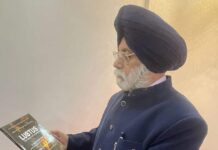
Aditya Kashyap
(Investment Banker & Former VP- JP Morgan Chase Bank)
Chairman- Indo American Chamber of Commerce
(Business Development, Strategies and Foreign Direct Investments)
The COVID-19 pandemic is one of the few episodes in recorded history where all of humanity faces a common existential threat. Within four months, the virus has spread around the world and imperiled not just our health and wellbeing, but also our social and economic networks.
We have entered, to borrow an oft-repeated phrase, ‘an era of radical uncertainty’ in which we are racing to craft appropriate responses, not only to secure safe health outcomes for all, but also to ensure that lifestyles and livelihoods are protected.
An opportunity for reforms
All crises are also opportunities for radical reform, for re-aligning priorities, and for tweaking policies in pursuit of the greater common good. History can serve, in the words of Pulitzer Prize winning writer David McCullough, as “a guide to navigation in perilous times” [1]. We might, in these trying times, take inspiration from President Franklin Delano Roosevelt’s ‘New Deal’, a series of reforms enacted between 1933 and 1939 that lifted the United States out of the Great Depression and restored hope to the American people. It focused on the ‘three Rs’ of relief for the vulnerable, recovery of the economy, and reform of the financial system– useful Mantras to keep in mind, as India seeks to re-invigorate its economy.
The pandemic has exposed fault lines in the global trade and financial architecture, disrupting our travel patterns, global manufacturing value-chains, and governance systems. The crisis brings home some potent lessons: individual health outcomes cannot be divorced from the health and hygiene systems of the community, that national borders are no defense against threats from nature, and that collective global action is increasingly a sine-qua-non for our own individual protection from such events. The hope remains that the COVID-19 crisis brings about a global epiphany regarding the need for saner responses to the other formidable (and less immediately visible) threat: the effects of climate change. Once this episode is behind us, if its only legacy is to bequeath us a wiser and more deliberative approach to balancing the often-conflicting objectives of economic progress and environment protection, then much good would have come of it.
Life after lockdowns: reviving the economy
Like other countries, India is also seeking to steer a judicious path between the need to insulate the population, and to revive the economic engine. The rigorous national lockdown has succeeded in slowing the spread of the virus, and the current thinking in the government is to open the country for business in a carefully calibrated manner, focusing on reviving sectors like agriculture, manufacturing, and services; while isolating geographic hotspots and vulnerable groups. The most compelling requirement for reviving the economy is to effectively manage the emergence from the lockdown, ensuring that supply chains are reopened, that manufacturing and service enterprises are free to operate, while ensuring basic health hygiene.
The first charge on the government is to protect the lives and entitlements of the most vulnerable people at the bottom of the pyramid-a daunting task, given that the unorganized sector represents over 90 per cent of the workforce [2]. India has millions of migrant workers, who are in acute distress, bereft of income support or home comfort. The first round of relief has rightly been the package of INR1.7 trillion [3] for the vulnerable, along with measures like reopening Mahatma Gandhi National Rural Employment Guarantee Act (MGNREGA) work. Much more needs to be done, and much more is expected, particularly a stimulus- cum-relief package that is imminent at the time of writing. There are demands and expectations that this package will be in the region of at least INR5-6 trillion, around 3 per cent of the country’s GDP [4]. This package could encompass fiscal stimulus, liquidity in the system, tax deferral, credit-protection, and business-continuity and sustenance assistance for small enterprises. The agriculture sector, which constitutes around 15 per cent of the GDP [5], also needs immediate relief, in terms of facilitating market access for the current rabi crop under harvesting, as well as funding support for farmers to commit to the imminent kharif crop, come June.
Apart from agriculture, sectoral stimulus packages and prioritization of relief and rehabilitation measures are warranted, given the substantial damages inflicted on sectors like tourism, hospitality, transportation, which have very large employment absorption levels.
Another area of focus needs to be infrastructure, not just for creating assets for the future, but also for absorbing employment in sectors like construction. The government’s recently announced National Infrastructure Pipeline of around INR100 trillion [6] could be re-prioritized by frontloading projects that soak up relatively greater levels of employment.
Two perfect storms: the pandemic and geopolitical disruptions
We also need to think beyond measures to mitigate the impact of the crisis, and around opportunities that may arise for India from global disruptions. Much of India’s economic reform of the early nineties was forced on us on the back of a public-finance crisis, and we also need to think beyond crisis management now, about how we can further refine our economic policies and modernize our infrastructure, particularly around logistics, for fostering more inward investment. The convergence of two perfect storms-the pandemic and the geopolitics-driven disruptions recently seen in global trade and investment flows, may be India’s opportunity to become one of the key nodes of the global value chain. We need to set up two national missions, with the same zeal and focus that went into improving India’s ease-of-doing business rankings; one around reducing process friction for inward investment, and another for improving the ease of undertaking trans-national trade.
We all tend to put our differences aside and come together when faced with an external challenge and that is presumably the most important element for emerging stronger and better, a pan-national coming together around common goals: alleviating distress, protecting the population, and creating better futures for every Indian.
[1] Historian addresses Wesleyan, New York Times, 4 June 1984
[2] Employment in informal sector and conditions of informal employment Volume IV 2013-2014, Government of India, 2 January 2015
[3] Finance Minister announces Rs 1.70 Lakh Crore relief package under Pradhan Mantri Garib Kalyan Yojana for the poor to help them fight the battle against Corona Virus, Ministry of Finance, 26 March 2020
[4] India needs 3% of GDP – not 5% – for coronavirus stimulus: Rangarajan, Business Today, 20 April 2020
[5] Economic Survey 2019-20, Government of India, 31 January 2020
[6] Finance Minister Smt Nirmala Sitharaman releases Report of the Task Force on National Infrastructure Pipeline for 2019-2025, Ministry of Finance, 31 December 2020 Source: Elias George, Partner and Head, Infrastructure, Government, and Healthcare, KPMG, INDIA.















